BUSN20017 - Self-Reflection Essay on Effective Business Communication
VerifiedAdded on 2023/06/11
|16
|4811
|252
Essay
AI Summary
This essay is a reflective analysis of the author's communication skills, utilizing tools like the Self-Perceived Communication Competence Scale, Non-Verbal Immediacy Scale, Personal Report of Intercultural Communication Apprehension, Talkaholic Scale, and Tolerance for Disagreement. The author identifies two key areas of weakness: intercultural communication apprehension and a high tolerance for disagreement, leading to submissiveness. These issues are illustrated with real-life incidents, including difficulties managing a diverse workforce and failing to advocate for their team, resulting in negative consequences. The literature review emphasizes the importance of cross-cultural communication and effective negotiation strategies. The essay concludes by highlighting the need for improvements in communication style to become a more effective manager. Desklib offers a variety of resources, including past papers and solved assignments, to aid students in their studies.
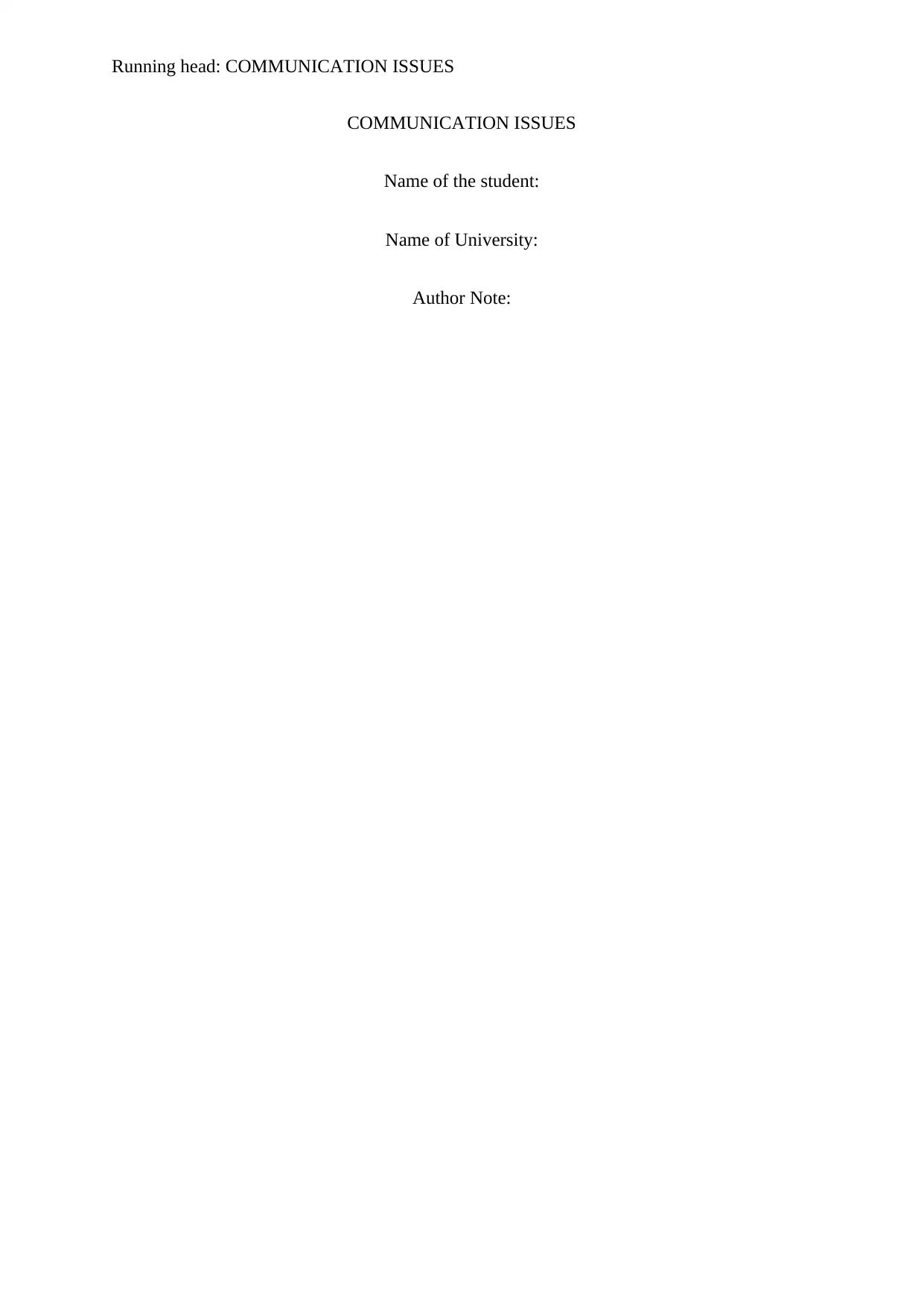
Running head: COMMUNICATION ISSUES
COMMUNICATION ISSUES
Name of the student:
Name of University:
Author Note:
COMMUNICATION ISSUES
Name of the student:
Name of University:
Author Note:
Paraphrase This Document
Need a fresh take? Get an instant paraphrase of this document with our AI Paraphraser

1COMMUNICATION ISSUES
In this global business proves, where the organisations are constantly changing
themselves to match with the markets, the great communicators have a special place. This is
because the entire business has been processing according to the ideology of the effective
leaders who motivate the employees to enhance their production in one hand and convincing
the consumers my handling their demands on the other. All these depend on the efficient style
of speaking with all the stakeholder through this the companies can manipulate as well as
pacify their associates. In the process of becoming a successful communicator, diagnosing the
issues in my communication in essential and in doing so, I have used some effective tools
which have helped me a lot in identifying my weaknesses. In this process I have used five
very important yet simple tools based on which I have diagnosed two of my very weak sides
of communication. This particular essay focusses on the effectiveness of the communication
diagnosis tools which judge my own communication style across various areas such as verbal
communication, active listening, non- verbal, and assertiveness perception. This reflective
essay discusses the communication competencies through my knowledge and ability to
perform contextually appropriate communicative behaviours. It contains a literature review
which discusses the two issues I have identified in the diagnosis process and concludes within
action plan.
In order to find out the problems with my communication style, I have been helped
with five effective diagnosis tools which are closely related to the analysis of the prominent
communication. The first tool I have used is Self-Perceived Communication Competence
Scale or SPCC (McCroskey, McCroskey & Richmond, 2006). Through this particular tools I
was able to identify the communication competency in the highly communication situation
where there is a wide range of listener present to listen to me. The second tool I have used is
Non-Verbal Immediacy Scale Self-Report or NIS through which I was able to identify the
level to which I use body gestures while communicating with others and how they feel in this
In this global business proves, where the organisations are constantly changing
themselves to match with the markets, the great communicators have a special place. This is
because the entire business has been processing according to the ideology of the effective
leaders who motivate the employees to enhance their production in one hand and convincing
the consumers my handling their demands on the other. All these depend on the efficient style
of speaking with all the stakeholder through this the companies can manipulate as well as
pacify their associates. In the process of becoming a successful communicator, diagnosing the
issues in my communication in essential and in doing so, I have used some effective tools
which have helped me a lot in identifying my weaknesses. In this process I have used five
very important yet simple tools based on which I have diagnosed two of my very weak sides
of communication. This particular essay focusses on the effectiveness of the communication
diagnosis tools which judge my own communication style across various areas such as verbal
communication, active listening, non- verbal, and assertiveness perception. This reflective
essay discusses the communication competencies through my knowledge and ability to
perform contextually appropriate communicative behaviours. It contains a literature review
which discusses the two issues I have identified in the diagnosis process and concludes within
action plan.
In order to find out the problems with my communication style, I have been helped
with five effective diagnosis tools which are closely related to the analysis of the prominent
communication. The first tool I have used is Self-Perceived Communication Competence
Scale or SPCC (McCroskey, McCroskey & Richmond, 2006). Through this particular tools I
was able to identify the communication competency in the highly communication situation
where there is a wide range of listener present to listen to me. The second tool I have used is
Non-Verbal Immediacy Scale Self-Report or NIS through which I was able to identify the
level to which I use body gestures while communicating with others and how they feel in this
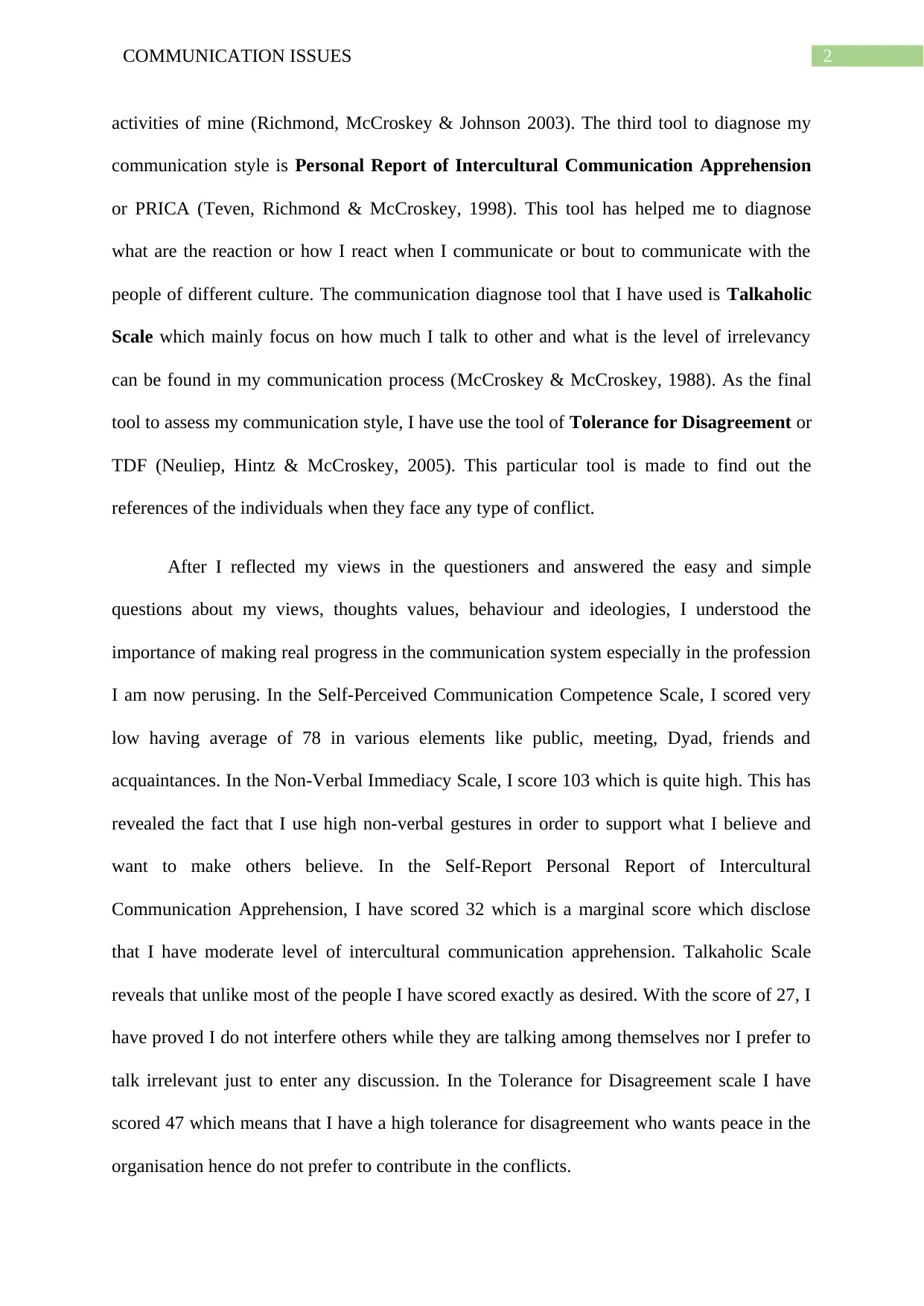
2COMMUNICATION ISSUES
activities of mine (Richmond, McCroskey & Johnson 2003). The third tool to diagnose my
communication style is Personal Report of Intercultural Communication Apprehension
or PRICA (Teven, Richmond & McCroskey, 1998). This tool has helped me to diagnose
what are the reaction or how I react when I communicate or bout to communicate with the
people of different culture. The communication diagnose tool that I have used is Talkaholic
Scale which mainly focus on how much I talk to other and what is the level of irrelevancy
can be found in my communication process (McCroskey & McCroskey, 1988). As the final
tool to assess my communication style, I have use the tool of Tolerance for Disagreement or
TDF (Neuliep, Hintz & McCroskey, 2005). This particular tool is made to find out the
references of the individuals when they face any type of conflict.
After I reflected my views in the questioners and answered the easy and simple
questions about my views, thoughts values, behaviour and ideologies, I understood the
importance of making real progress in the communication system especially in the profession
I am now perusing. In the Self-Perceived Communication Competence Scale, I scored very
low having average of 78 in various elements like public, meeting, Dyad, friends and
acquaintances. In the Non-Verbal Immediacy Scale, I score 103 which is quite high. This has
revealed the fact that I use high non-verbal gestures in order to support what I believe and
want to make others believe. In the Self-Report Personal Report of Intercultural
Communication Apprehension, I have scored 32 which is a marginal score which disclose
that I have moderate level of intercultural communication apprehension. Talkaholic Scale
reveals that unlike most of the people I have scored exactly as desired. With the score of 27, I
have proved I do not interfere others while they are talking among themselves nor I prefer to
talk irrelevant just to enter any discussion. In the Tolerance for Disagreement scale I have
scored 47 which means that I have a high tolerance for disagreement who wants peace in the
organisation hence do not prefer to contribute in the conflicts.
activities of mine (Richmond, McCroskey & Johnson 2003). The third tool to diagnose my
communication style is Personal Report of Intercultural Communication Apprehension
or PRICA (Teven, Richmond & McCroskey, 1998). This tool has helped me to diagnose
what are the reaction or how I react when I communicate or bout to communicate with the
people of different culture. The communication diagnose tool that I have used is Talkaholic
Scale which mainly focus on how much I talk to other and what is the level of irrelevancy
can be found in my communication process (McCroskey & McCroskey, 1988). As the final
tool to assess my communication style, I have use the tool of Tolerance for Disagreement or
TDF (Neuliep, Hintz & McCroskey, 2005). This particular tool is made to find out the
references of the individuals when they face any type of conflict.
After I reflected my views in the questioners and answered the easy and simple
questions about my views, thoughts values, behaviour and ideologies, I understood the
importance of making real progress in the communication system especially in the profession
I am now perusing. In the Self-Perceived Communication Competence Scale, I scored very
low having average of 78 in various elements like public, meeting, Dyad, friends and
acquaintances. In the Non-Verbal Immediacy Scale, I score 103 which is quite high. This has
revealed the fact that I use high non-verbal gestures in order to support what I believe and
want to make others believe. In the Self-Report Personal Report of Intercultural
Communication Apprehension, I have scored 32 which is a marginal score which disclose
that I have moderate level of intercultural communication apprehension. Talkaholic Scale
reveals that unlike most of the people I have scored exactly as desired. With the score of 27, I
have proved I do not interfere others while they are talking among themselves nor I prefer to
talk irrelevant just to enter any discussion. In the Tolerance for Disagreement scale I have
scored 47 which means that I have a high tolerance for disagreement who wants peace in the
organisation hence do not prefer to contribute in the conflicts.
⊘ This is a preview!⊘
Do you want full access?
Subscribe today to unlock all pages.

Trusted by 1+ million students worldwide

3COMMUNICATION ISSUES
Based upon these score I have clearly identified two quite serious issues which I need
to immediately check and take initiatives to eradicate from my communication style. Despite
the fact that I have scored good in some of the techniques, but in most of the cases I have
grave weaknesses which are creating problem in many aspects of life. first of all, I have
pointed out that the communication told like Self-Report Personal Report of Intercultural
Communication Apprehension, I have scored so low that there will be surely some issues in
the organisation if I try to communicate with the employees from difference race or any type
of diversity. I feel uncomfortable in talking to these people from various background as I do
not feel confident about the relevancy of the subjects and I feel nervous thinking about the
perspectives of those which make me forget the actual theme based on which I was talking
about. This issue can be harmful for me because this tendency of not communicating with
strangers or people from different race or culture may lead me to a conflict for which I am not
at all ready. Moreover, my passivity can be a great issue from the people of different culture
as my silence can bear the feeling of arrogance for many of the cultures. Secondly, I have
found out that have score high in the Tolerance for Disagreement. This disclose the fact I am
very submissive and do not prefer to communicate with the authorities or even the
companions just to avoid conflicts. The interpersonal relation to me is more important than
any kind of individual success therefore, I fail to convey my own views to the opponent but
agree with the others. These two are the most important factors which have really affected my
values greatly and now have become the potential barriers in the process of being effective
managers in the organisations.
In this context two of the eminent incidents need to be shared. First was related with
the failure to manage the cross-cultural employees in the organisation and another was related
with the Tolerance for Disagreement in communication where I faced difficulty with the
fulfilling of the customers’ demands. The first incident took place when I was the in charge
Based upon these score I have clearly identified two quite serious issues which I need
to immediately check and take initiatives to eradicate from my communication style. Despite
the fact that I have scored good in some of the techniques, but in most of the cases I have
grave weaknesses which are creating problem in many aspects of life. first of all, I have
pointed out that the communication told like Self-Report Personal Report of Intercultural
Communication Apprehension, I have scored so low that there will be surely some issues in
the organisation if I try to communicate with the employees from difference race or any type
of diversity. I feel uncomfortable in talking to these people from various background as I do
not feel confident about the relevancy of the subjects and I feel nervous thinking about the
perspectives of those which make me forget the actual theme based on which I was talking
about. This issue can be harmful for me because this tendency of not communicating with
strangers or people from different race or culture may lead me to a conflict for which I am not
at all ready. Moreover, my passivity can be a great issue from the people of different culture
as my silence can bear the feeling of arrogance for many of the cultures. Secondly, I have
found out that have score high in the Tolerance for Disagreement. This disclose the fact I am
very submissive and do not prefer to communicate with the authorities or even the
companions just to avoid conflicts. The interpersonal relation to me is more important than
any kind of individual success therefore, I fail to convey my own views to the opponent but
agree with the others. These two are the most important factors which have really affected my
values greatly and now have become the potential barriers in the process of being effective
managers in the organisations.
In this context two of the eminent incidents need to be shared. First was related with
the failure to manage the cross-cultural employees in the organisation and another was related
with the Tolerance for Disagreement in communication where I faced difficulty with the
fulfilling of the customers’ demands. The first incident took place when I was the in charge
Paraphrase This Document
Need a fresh take? Get an instant paraphrase of this document with our AI Paraphraser
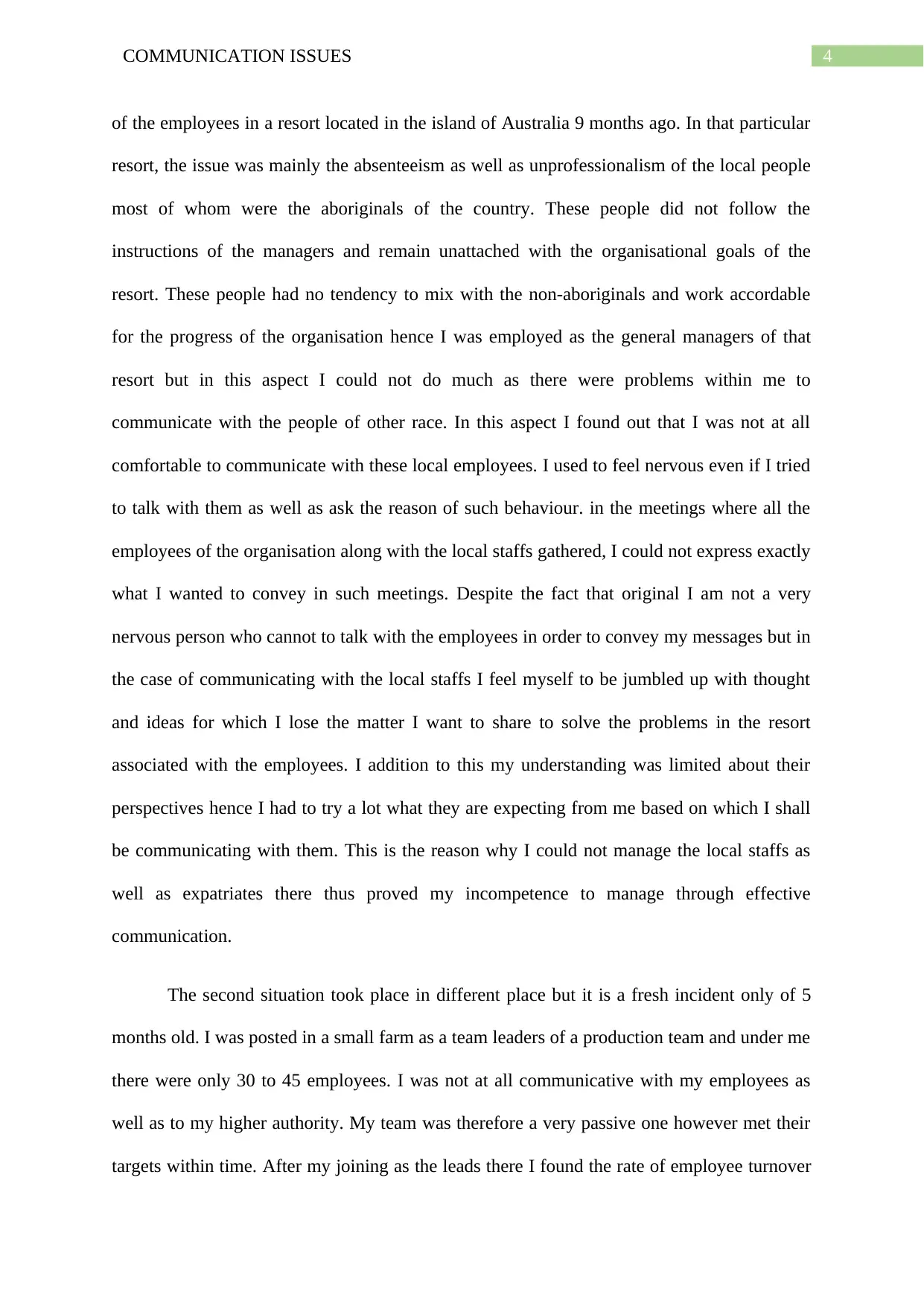
4COMMUNICATION ISSUES
of the employees in a resort located in the island of Australia 9 months ago. In that particular
resort, the issue was mainly the absenteeism as well as unprofessionalism of the local people
most of whom were the aboriginals of the country. These people did not follow the
instructions of the managers and remain unattached with the organisational goals of the
resort. These people had no tendency to mix with the non-aboriginals and work accordable
for the progress of the organisation hence I was employed as the general managers of that
resort but in this aspect I could not do much as there were problems within me to
communicate with the people of other race. In this aspect I found out that I was not at all
comfortable to communicate with these local employees. I used to feel nervous even if I tried
to talk with them as well as ask the reason of such behaviour. in the meetings where all the
employees of the organisation along with the local staffs gathered, I could not express exactly
what I wanted to convey in such meetings. Despite the fact that original I am not a very
nervous person who cannot to talk with the employees in order to convey my messages but in
the case of communicating with the local staffs I feel myself to be jumbled up with thought
and ideas for which I lose the matter I want to share to solve the problems in the resort
associated with the employees. I addition to this my understanding was limited about their
perspectives hence I had to try a lot what they are expecting from me based on which I shall
be communicating with them. This is the reason why I could not manage the local staffs as
well as expatriates there thus proved my incompetence to manage through effective
communication.
The second situation took place in different place but it is a fresh incident only of 5
months old. I was posted in a small farm as a team leaders of a production team and under me
there were only 30 to 45 employees. I was not at all communicative with my employees as
well as to my higher authority. My team was therefore a very passive one however met their
targets within time. After my joining as the leads there I found the rate of employee turnover
of the employees in a resort located in the island of Australia 9 months ago. In that particular
resort, the issue was mainly the absenteeism as well as unprofessionalism of the local people
most of whom were the aboriginals of the country. These people did not follow the
instructions of the managers and remain unattached with the organisational goals of the
resort. These people had no tendency to mix with the non-aboriginals and work accordable
for the progress of the organisation hence I was employed as the general managers of that
resort but in this aspect I could not do much as there were problems within me to
communicate with the people of other race. In this aspect I found out that I was not at all
comfortable to communicate with these local employees. I used to feel nervous even if I tried
to talk with them as well as ask the reason of such behaviour. in the meetings where all the
employees of the organisation along with the local staffs gathered, I could not express exactly
what I wanted to convey in such meetings. Despite the fact that original I am not a very
nervous person who cannot to talk with the employees in order to convey my messages but in
the case of communicating with the local staffs I feel myself to be jumbled up with thought
and ideas for which I lose the matter I want to share to solve the problems in the resort
associated with the employees. I addition to this my understanding was limited about their
perspectives hence I had to try a lot what they are expecting from me based on which I shall
be communicating with them. This is the reason why I could not manage the local staffs as
well as expatriates there thus proved my incompetence to manage through effective
communication.
The second situation took place in different place but it is a fresh incident only of 5
months old. I was posted in a small farm as a team leaders of a production team and under me
there were only 30 to 45 employees. I was not at all communicative with my employees as
well as to my higher authority. My team was therefore a very passive one however met their
targets within time. After my joining as the leads there I found the rate of employee turnover
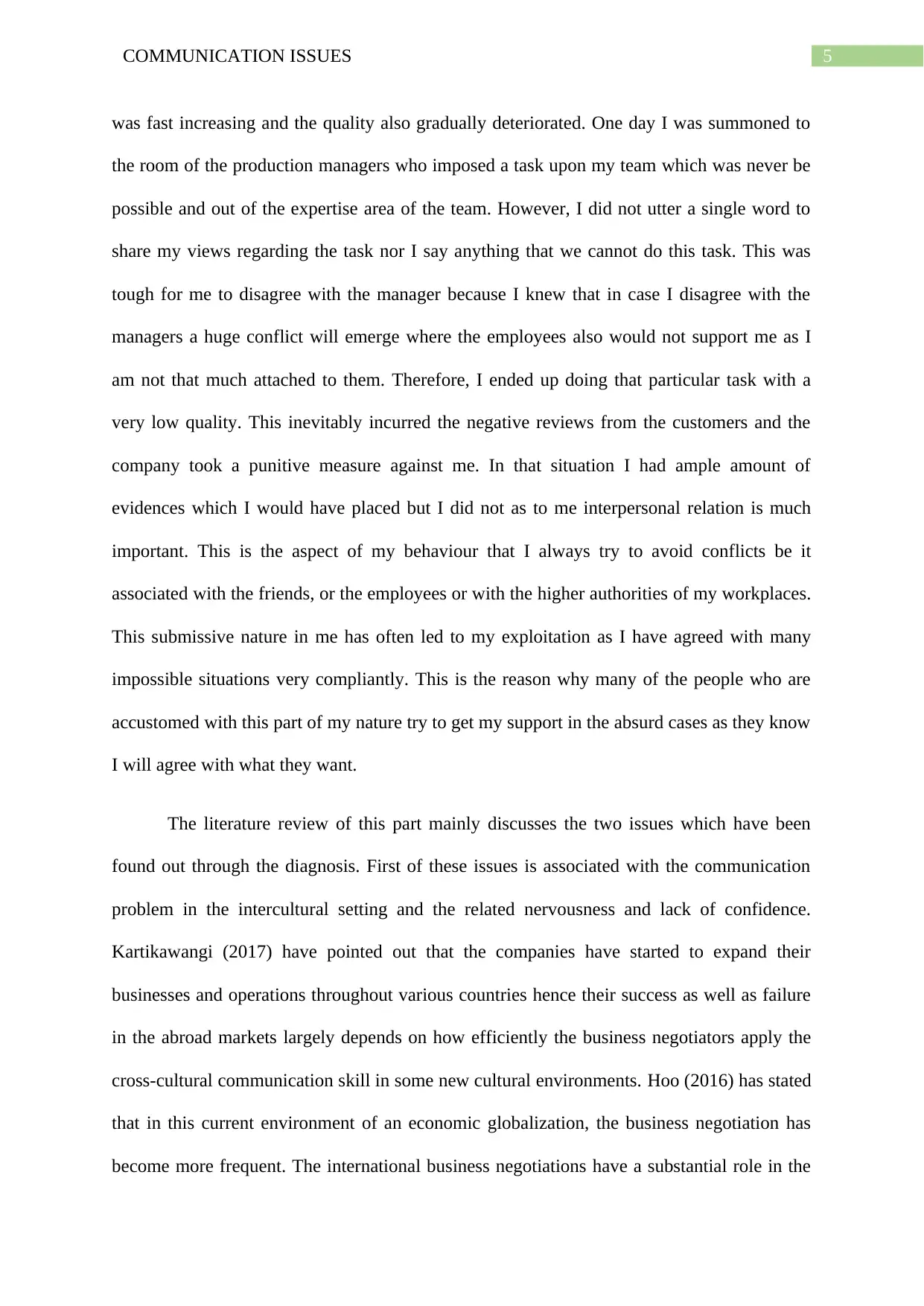
5COMMUNICATION ISSUES
was fast increasing and the quality also gradually deteriorated. One day I was summoned to
the room of the production managers who imposed a task upon my team which was never be
possible and out of the expertise area of the team. However, I did not utter a single word to
share my views regarding the task nor I say anything that we cannot do this task. This was
tough for me to disagree with the manager because I knew that in case I disagree with the
managers a huge conflict will emerge where the employees also would not support me as I
am not that much attached to them. Therefore, I ended up doing that particular task with a
very low quality. This inevitably incurred the negative reviews from the customers and the
company took a punitive measure against me. In that situation I had ample amount of
evidences which I would have placed but I did not as to me interpersonal relation is much
important. This is the aspect of my behaviour that I always try to avoid conflicts be it
associated with the friends, or the employees or with the higher authorities of my workplaces.
This submissive nature in me has often led to my exploitation as I have agreed with many
impossible situations very compliantly. This is the reason why many of the people who are
accustomed with this part of my nature try to get my support in the absurd cases as they know
I will agree with what they want.
The literature review of this part mainly discusses the two issues which have been
found out through the diagnosis. First of these issues is associated with the communication
problem in the intercultural setting and the related nervousness and lack of confidence.
Kartikawangi (2017) have pointed out that the companies have started to expand their
businesses and operations throughout various countries hence their success as well as failure
in the abroad markets largely depends on how efficiently the business negotiators apply the
cross-cultural communication skill in some new cultural environments. Hoo (2016) has stated
that in this current environment of an economic globalization, the business negotiation has
become more frequent. The international business negotiations have a substantial role in the
was fast increasing and the quality also gradually deteriorated. One day I was summoned to
the room of the production managers who imposed a task upon my team which was never be
possible and out of the expertise area of the team. However, I did not utter a single word to
share my views regarding the task nor I say anything that we cannot do this task. This was
tough for me to disagree with the manager because I knew that in case I disagree with the
managers a huge conflict will emerge where the employees also would not support me as I
am not that much attached to them. Therefore, I ended up doing that particular task with a
very low quality. This inevitably incurred the negative reviews from the customers and the
company took a punitive measure against me. In that situation I had ample amount of
evidences which I would have placed but I did not as to me interpersonal relation is much
important. This is the aspect of my behaviour that I always try to avoid conflicts be it
associated with the friends, or the employees or with the higher authorities of my workplaces.
This submissive nature in me has often led to my exploitation as I have agreed with many
impossible situations very compliantly. This is the reason why many of the people who are
accustomed with this part of my nature try to get my support in the absurd cases as they know
I will agree with what they want.
The literature review of this part mainly discusses the two issues which have been
found out through the diagnosis. First of these issues is associated with the communication
problem in the intercultural setting and the related nervousness and lack of confidence.
Kartikawangi (2017) have pointed out that the companies have started to expand their
businesses and operations throughout various countries hence their success as well as failure
in the abroad markets largely depends on how efficiently the business negotiators apply the
cross-cultural communication skill in some new cultural environments. Hoo (2016) has stated
that in this current environment of an economic globalization, the business negotiation has
become more frequent. The international business negotiations have a substantial role in the
⊘ This is a preview!⊘
Do you want full access?
Subscribe today to unlock all pages.

Trusted by 1+ million students worldwide
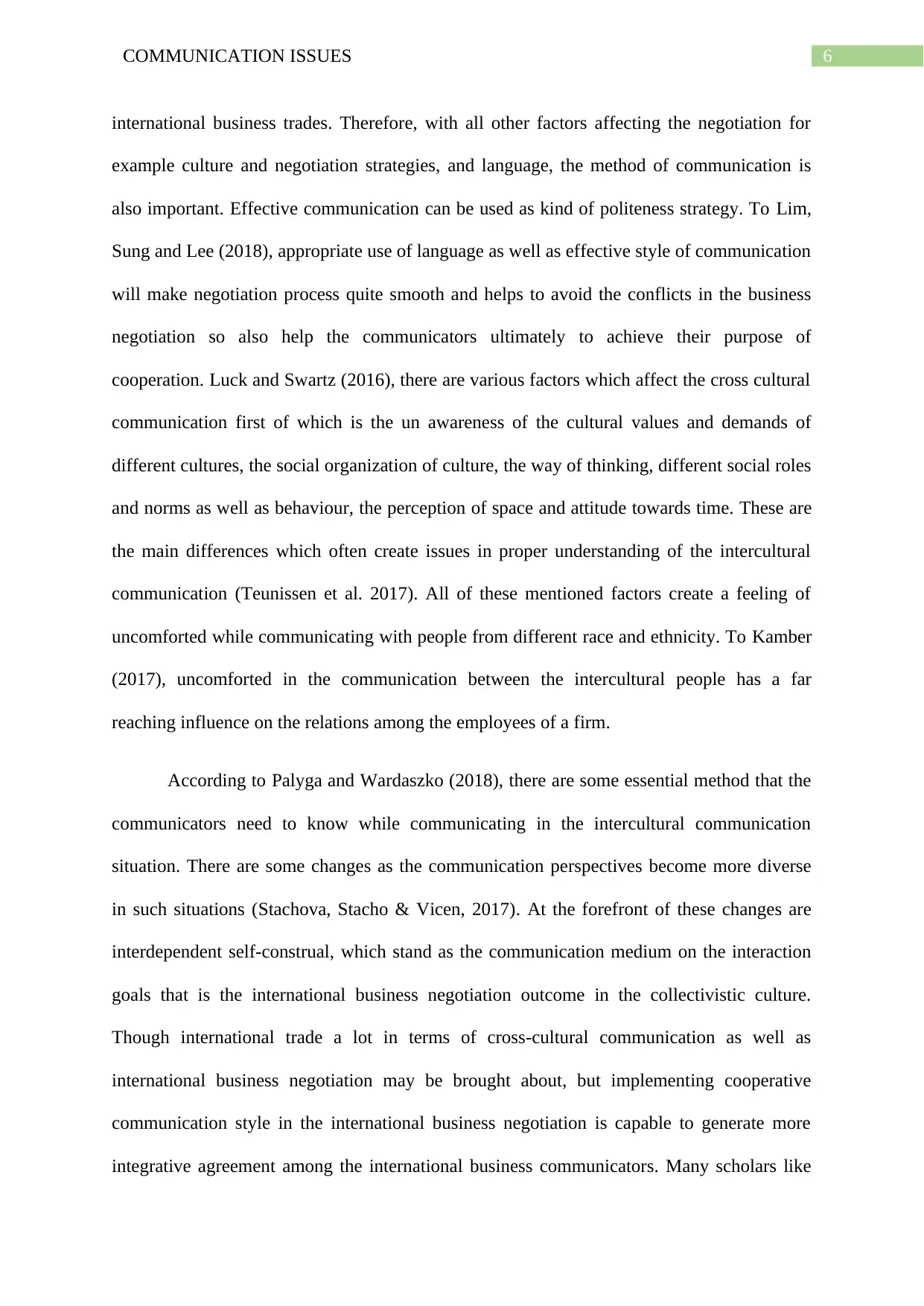
6COMMUNICATION ISSUES
international business trades. Therefore, with all other factors affecting the negotiation for
example culture and negotiation strategies, and language, the method of communication is
also important. Effective communication can be used as kind of politeness strategy. To Lim,
Sung and Lee (2018), appropriate use of language as well as effective style of communication
will make negotiation process quite smooth and helps to avoid the conflicts in the business
negotiation so also help the communicators ultimately to achieve their purpose of
cooperation. Luck and Swartz (2016), there are various factors which affect the cross cultural
communication first of which is the un awareness of the cultural values and demands of
different cultures, the social organization of culture, the way of thinking, different social roles
and norms as well as behaviour, the perception of space and attitude towards time. These are
the main differences which often create issues in proper understanding of the intercultural
communication (Teunissen et al. 2017). All of these mentioned factors create a feeling of
uncomforted while communicating with people from different race and ethnicity. To Kamber
(2017), uncomforted in the communication between the intercultural people has a far
reaching influence on the relations among the employees of a firm.
According to Palyga and Wardaszko (2018), there are some essential method that the
communicators need to know while communicating in the intercultural communication
situation. There are some changes as the communication perspectives become more diverse
in such situations (Stachova, Stacho & Vicen, 2017). At the forefront of these changes are
interdependent self-construal, which stand as the communication medium on the interaction
goals that is the international business negotiation outcome in the collectivistic culture.
Though international trade a lot in terms of cross-cultural communication as well as
international business negotiation may be brought about, but implementing cooperative
communication style in the international business negotiation is capable to generate more
integrative agreement among the international business communicators. Many scholars like
international business trades. Therefore, with all other factors affecting the negotiation for
example culture and negotiation strategies, and language, the method of communication is
also important. Effective communication can be used as kind of politeness strategy. To Lim,
Sung and Lee (2018), appropriate use of language as well as effective style of communication
will make negotiation process quite smooth and helps to avoid the conflicts in the business
negotiation so also help the communicators ultimately to achieve their purpose of
cooperation. Luck and Swartz (2016), there are various factors which affect the cross cultural
communication first of which is the un awareness of the cultural values and demands of
different cultures, the social organization of culture, the way of thinking, different social roles
and norms as well as behaviour, the perception of space and attitude towards time. These are
the main differences which often create issues in proper understanding of the intercultural
communication (Teunissen et al. 2017). All of these mentioned factors create a feeling of
uncomforted while communicating with people from different race and ethnicity. To Kamber
(2017), uncomforted in the communication between the intercultural people has a far
reaching influence on the relations among the employees of a firm.
According to Palyga and Wardaszko (2018), there are some essential method that the
communicators need to know while communicating in the intercultural communication
situation. There are some changes as the communication perspectives become more diverse
in such situations (Stachova, Stacho & Vicen, 2017). At the forefront of these changes are
interdependent self-construal, which stand as the communication medium on the interaction
goals that is the international business negotiation outcome in the collectivistic culture.
Though international trade a lot in terms of cross-cultural communication as well as
international business negotiation may be brought about, but implementing cooperative
communication style in the international business negotiation is capable to generate more
integrative agreement among the international business communicators. Many scholars like
Paraphrase This Document
Need a fresh take? Get an instant paraphrase of this document with our AI Paraphraser
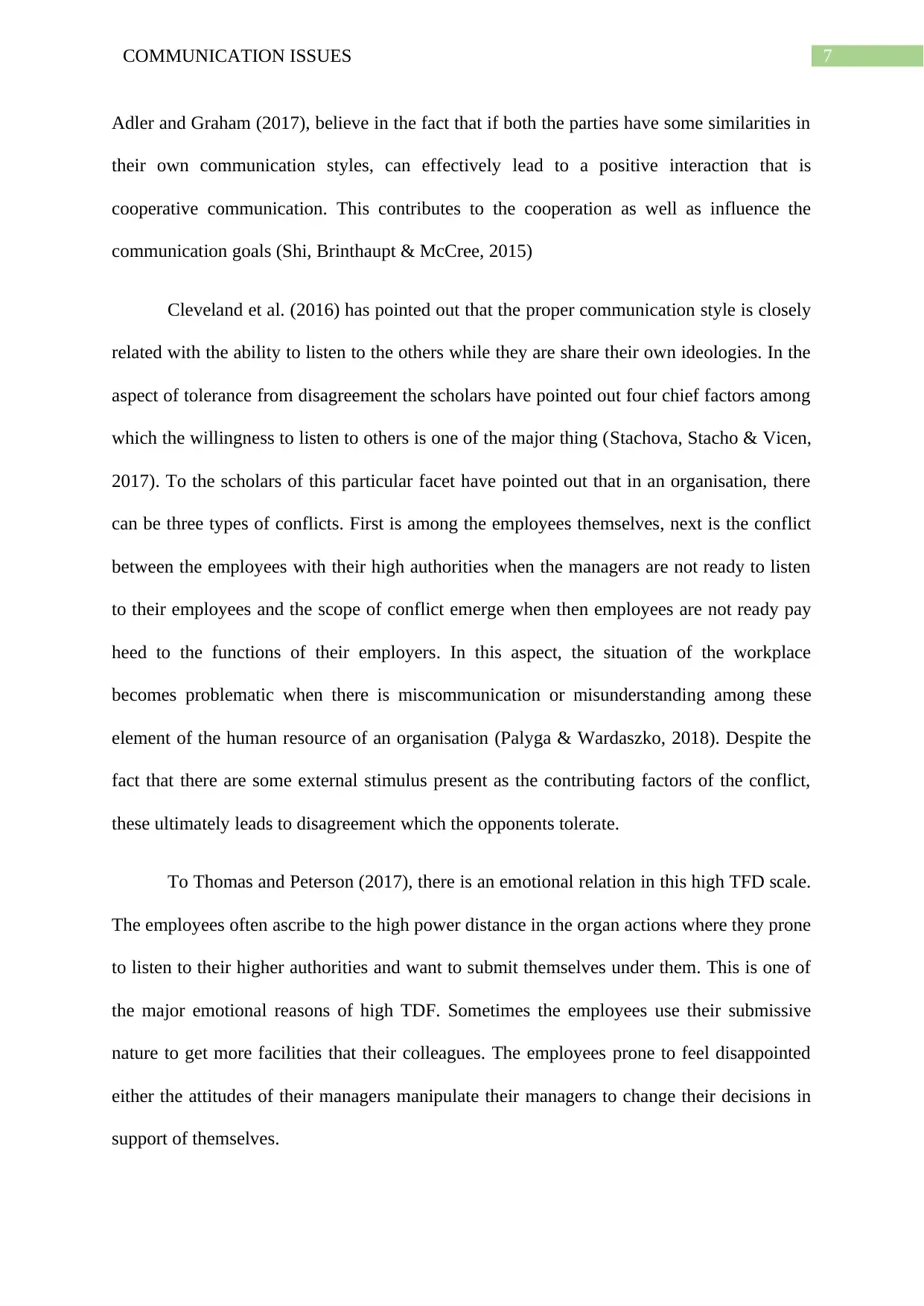
7COMMUNICATION ISSUES
Adler and Graham (2017), believe in the fact that if both the parties have some similarities in
their own communication styles, can effectively lead to a positive interaction that is
cooperative communication. This contributes to the cooperation as well as influence the
communication goals (Shi, Brinthaupt & McCree, 2015)
Cleveland et al. (2016) has pointed out that the proper communication style is closely
related with the ability to listen to the others while they are share their own ideologies. In the
aspect of tolerance from disagreement the scholars have pointed out four chief factors among
which the willingness to listen to others is one of the major thing (Stachova, Stacho & Vicen,
2017). To the scholars of this particular facet have pointed out that in an organisation, there
can be three types of conflicts. First is among the employees themselves, next is the conflict
between the employees with their high authorities when the managers are not ready to listen
to their employees and the scope of conflict emerge when then employees are not ready pay
heed to the functions of their employers. In this aspect, the situation of the workplace
becomes problematic when there is miscommunication or misunderstanding among these
element of the human resource of an organisation (Palyga & Wardaszko, 2018). Despite the
fact that there are some external stimulus present as the contributing factors of the conflict,
these ultimately leads to disagreement which the opponents tolerate.
To Thomas and Peterson (2017), there is an emotional relation in this high TFD scale.
The employees often ascribe to the high power distance in the organ actions where they prone
to listen to their higher authorities and want to submit themselves under them. This is one of
the major emotional reasons of high TDF. Sometimes the employees use their submissive
nature to get more facilities that their colleagues. The employees prone to feel disappointed
either the attitudes of their managers manipulate their managers to change their decisions in
support of themselves.
Adler and Graham (2017), believe in the fact that if both the parties have some similarities in
their own communication styles, can effectively lead to a positive interaction that is
cooperative communication. This contributes to the cooperation as well as influence the
communication goals (Shi, Brinthaupt & McCree, 2015)
Cleveland et al. (2016) has pointed out that the proper communication style is closely
related with the ability to listen to the others while they are share their own ideologies. In the
aspect of tolerance from disagreement the scholars have pointed out four chief factors among
which the willingness to listen to others is one of the major thing (Stachova, Stacho & Vicen,
2017). To the scholars of this particular facet have pointed out that in an organisation, there
can be three types of conflicts. First is among the employees themselves, next is the conflict
between the employees with their high authorities when the managers are not ready to listen
to their employees and the scope of conflict emerge when then employees are not ready pay
heed to the functions of their employers. In this aspect, the situation of the workplace
becomes problematic when there is miscommunication or misunderstanding among these
element of the human resource of an organisation (Palyga & Wardaszko, 2018). Despite the
fact that there are some external stimulus present as the contributing factors of the conflict,
these ultimately leads to disagreement which the opponents tolerate.
To Thomas and Peterson (2017), there is an emotional relation in this high TFD scale.
The employees often ascribe to the high power distance in the organ actions where they prone
to listen to their higher authorities and want to submit themselves under them. This is one of
the major emotional reasons of high TDF. Sometimes the employees use their submissive
nature to get more facilities that their colleagues. The employees prone to feel disappointed
either the attitudes of their managers manipulate their managers to change their decisions in
support of themselves.
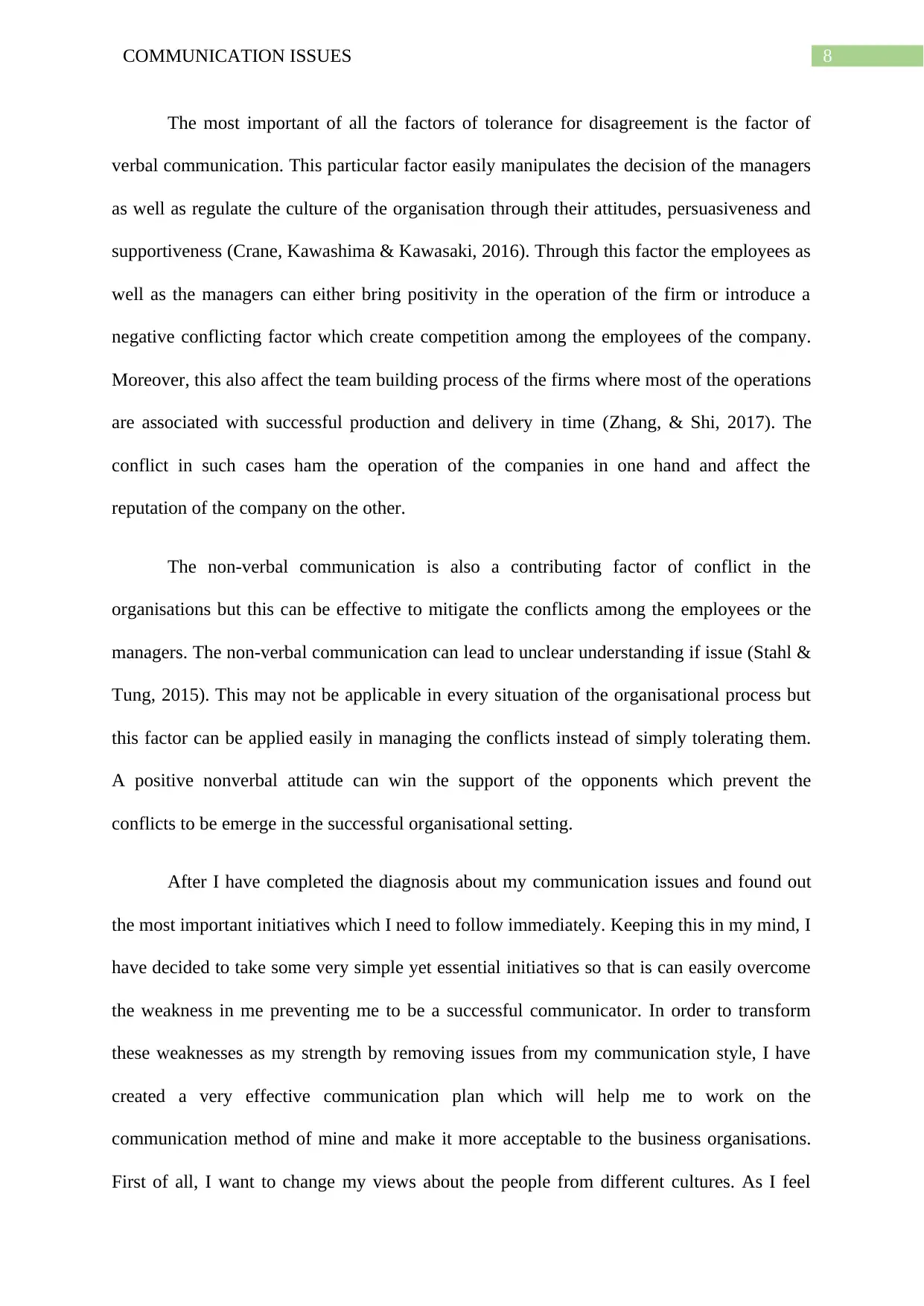
8COMMUNICATION ISSUES
The most important of all the factors of tolerance for disagreement is the factor of
verbal communication. This particular factor easily manipulates the decision of the managers
as well as regulate the culture of the organisation through their attitudes, persuasiveness and
supportiveness (Crane, Kawashima & Kawasaki, 2016). Through this factor the employees as
well as the managers can either bring positivity in the operation of the firm or introduce a
negative conflicting factor which create competition among the employees of the company.
Moreover, this also affect the team building process of the firms where most of the operations
are associated with successful production and delivery in time (Zhang, & Shi, 2017). The
conflict in such cases ham the operation of the companies in one hand and affect the
reputation of the company on the other.
The non-verbal communication is also a contributing factor of conflict in the
organisations but this can be effective to mitigate the conflicts among the employees or the
managers. The non-verbal communication can lead to unclear understanding if issue (Stahl &
Tung, 2015). This may not be applicable in every situation of the organisational process but
this factor can be applied easily in managing the conflicts instead of simply tolerating them.
A positive nonverbal attitude can win the support of the opponents which prevent the
conflicts to be emerge in the successful organisational setting.
After I have completed the diagnosis about my communication issues and found out
the most important initiatives which I need to follow immediately. Keeping this in my mind, I
have decided to take some very simple yet essential initiatives so that is can easily overcome
the weakness in me preventing me to be a successful communicator. In order to transform
these weaknesses as my strength by removing issues from my communication style, I have
created a very effective communication plan which will help me to work on the
communication method of mine and make it more acceptable to the business organisations.
First of all, I want to change my views about the people from different cultures. As I feel
The most important of all the factors of tolerance for disagreement is the factor of
verbal communication. This particular factor easily manipulates the decision of the managers
as well as regulate the culture of the organisation through their attitudes, persuasiveness and
supportiveness (Crane, Kawashima & Kawasaki, 2016). Through this factor the employees as
well as the managers can either bring positivity in the operation of the firm or introduce a
negative conflicting factor which create competition among the employees of the company.
Moreover, this also affect the team building process of the firms where most of the operations
are associated with successful production and delivery in time (Zhang, & Shi, 2017). The
conflict in such cases ham the operation of the companies in one hand and affect the
reputation of the company on the other.
The non-verbal communication is also a contributing factor of conflict in the
organisations but this can be effective to mitigate the conflicts among the employees or the
managers. The non-verbal communication can lead to unclear understanding if issue (Stahl &
Tung, 2015). This may not be applicable in every situation of the organisational process but
this factor can be applied easily in managing the conflicts instead of simply tolerating them.
A positive nonverbal attitude can win the support of the opponents which prevent the
conflicts to be emerge in the successful organisational setting.
After I have completed the diagnosis about my communication issues and found out
the most important initiatives which I need to follow immediately. Keeping this in my mind, I
have decided to take some very simple yet essential initiatives so that is can easily overcome
the weakness in me preventing me to be a successful communicator. In order to transform
these weaknesses as my strength by removing issues from my communication style, I have
created a very effective communication plan which will help me to work on the
communication method of mine and make it more acceptable to the business organisations.
First of all, I want to change my views about the people from different cultures. As I feel
⊘ This is a preview!⊘
Do you want full access?
Subscribe today to unlock all pages.

Trusted by 1+ million students worldwide
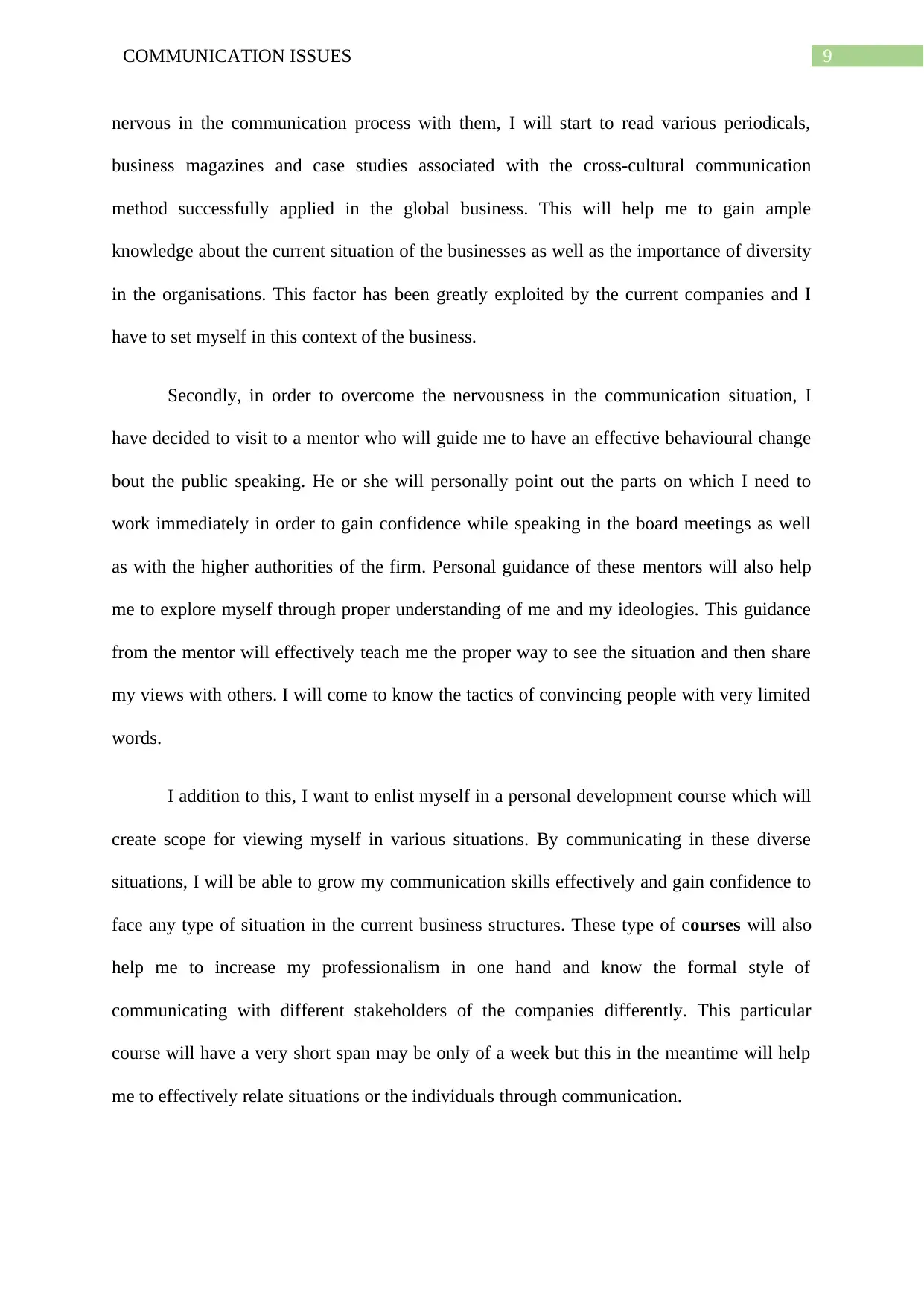
9COMMUNICATION ISSUES
nervous in the communication process with them, I will start to read various periodicals,
business magazines and case studies associated with the cross-cultural communication
method successfully applied in the global business. This will help me to gain ample
knowledge about the current situation of the businesses as well as the importance of diversity
in the organisations. This factor has been greatly exploited by the current companies and I
have to set myself in this context of the business.
Secondly, in order to overcome the nervousness in the communication situation, I
have decided to visit to a mentor who will guide me to have an effective behavioural change
bout the public speaking. He or she will personally point out the parts on which I need to
work immediately in order to gain confidence while speaking in the board meetings as well
as with the higher authorities of the firm. Personal guidance of these mentors will also help
me to explore myself through proper understanding of me and my ideologies. This guidance
from the mentor will effectively teach me the proper way to see the situation and then share
my views with others. I will come to know the tactics of convincing people with very limited
words.
I addition to this, I want to enlist myself in a personal development course which will
create scope for viewing myself in various situations. By communicating in these diverse
situations, I will be able to grow my communication skills effectively and gain confidence to
face any type of situation in the current business structures. These type of courses will also
help me to increase my professionalism in one hand and know the formal style of
communicating with different stakeholders of the companies differently. This particular
course will have a very short span may be only of a week but this in the meantime will help
me to effectively relate situations or the individuals through communication.
nervous in the communication process with them, I will start to read various periodicals,
business magazines and case studies associated with the cross-cultural communication
method successfully applied in the global business. This will help me to gain ample
knowledge about the current situation of the businesses as well as the importance of diversity
in the organisations. This factor has been greatly exploited by the current companies and I
have to set myself in this context of the business.
Secondly, in order to overcome the nervousness in the communication situation, I
have decided to visit to a mentor who will guide me to have an effective behavioural change
bout the public speaking. He or she will personally point out the parts on which I need to
work immediately in order to gain confidence while speaking in the board meetings as well
as with the higher authorities of the firm. Personal guidance of these mentors will also help
me to explore myself through proper understanding of me and my ideologies. This guidance
from the mentor will effectively teach me the proper way to see the situation and then share
my views with others. I will come to know the tactics of convincing people with very limited
words.
I addition to this, I want to enlist myself in a personal development course which will
create scope for viewing myself in various situations. By communicating in these diverse
situations, I will be able to grow my communication skills effectively and gain confidence to
face any type of situation in the current business structures. These type of courses will also
help me to increase my professionalism in one hand and know the formal style of
communicating with different stakeholders of the companies differently. This particular
course will have a very short span may be only of a week but this in the meantime will help
me to effectively relate situations or the individuals through communication.
Paraphrase This Document
Need a fresh take? Get an instant paraphrase of this document with our AI Paraphraser
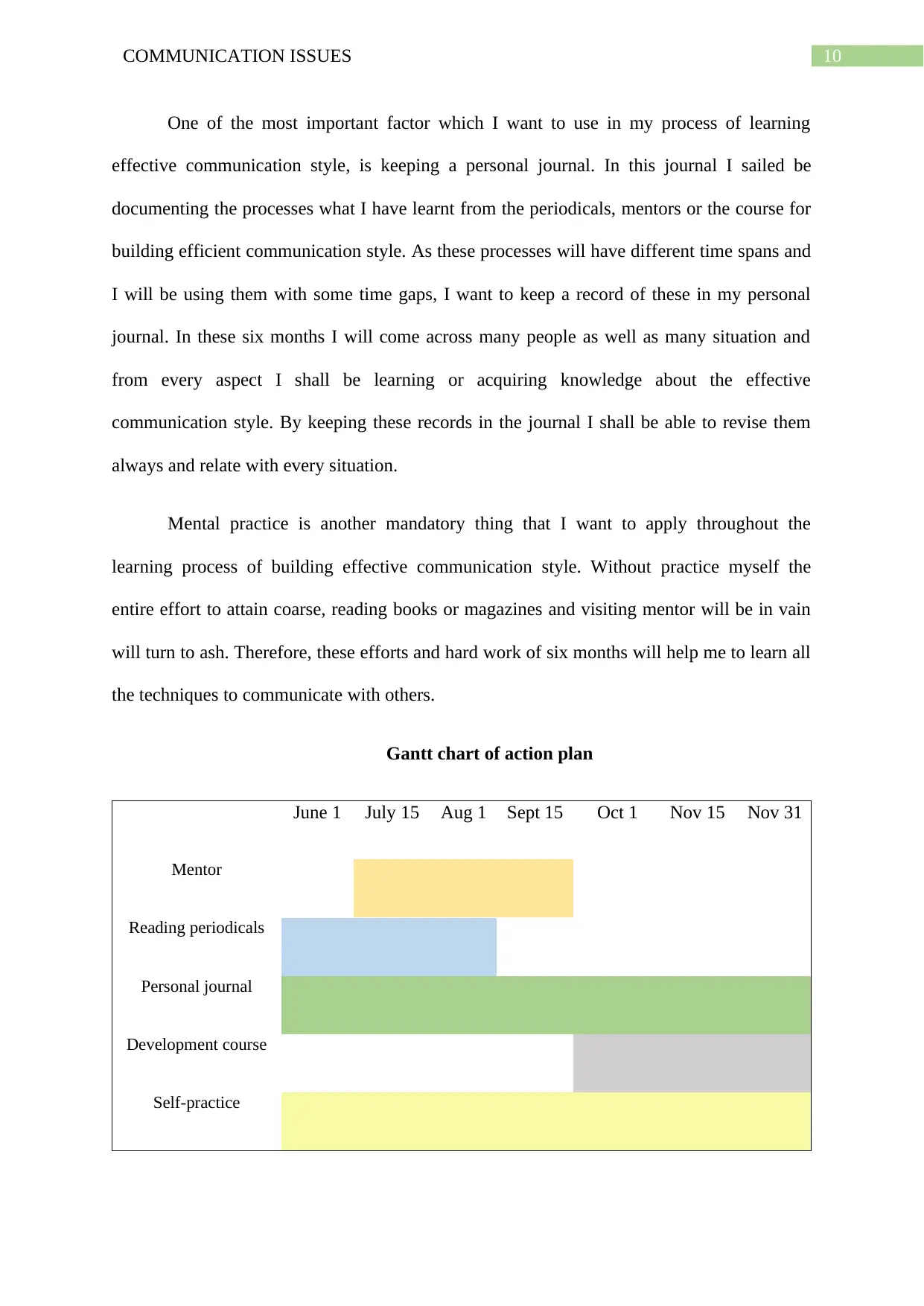
10COMMUNICATION ISSUES
One of the most important factor which I want to use in my process of learning
effective communication style, is keeping a personal journal. In this journal I sailed be
documenting the processes what I have learnt from the periodicals, mentors or the course for
building efficient communication style. As these processes will have different time spans and
I will be using them with some time gaps, I want to keep a record of these in my personal
journal. In these six months I will come across many people as well as many situation and
from every aspect I shall be learning or acquiring knowledge about the effective
communication style. By keeping these records in the journal I shall be able to revise them
always and relate with every situation.
Mental practice is another mandatory thing that I want to apply throughout the
learning process of building effective communication style. Without practice myself the
entire effort to attain coarse, reading books or magazines and visiting mentor will be in vain
will turn to ash. Therefore, these efforts and hard work of six months will help me to learn all
the techniques to communicate with others.
Gantt chart of action plan
June 1 July 15 Aug 1 Sept 15 Oct 1 Nov 15 Nov 31
Mentor
Reading periodicals
Personal journal
Development course
Self-practice
One of the most important factor which I want to use in my process of learning
effective communication style, is keeping a personal journal. In this journal I sailed be
documenting the processes what I have learnt from the periodicals, mentors or the course for
building efficient communication style. As these processes will have different time spans and
I will be using them with some time gaps, I want to keep a record of these in my personal
journal. In these six months I will come across many people as well as many situation and
from every aspect I shall be learning or acquiring knowledge about the effective
communication style. By keeping these records in the journal I shall be able to revise them
always and relate with every situation.
Mental practice is another mandatory thing that I want to apply throughout the
learning process of building effective communication style. Without practice myself the
entire effort to attain coarse, reading books or magazines and visiting mentor will be in vain
will turn to ash. Therefore, these efforts and hard work of six months will help me to learn all
the techniques to communicate with others.
Gantt chart of action plan
June 1 July 15 Aug 1 Sept 15 Oct 1 Nov 15 Nov 31
Mentor
Reading periodicals
Personal journal
Development course
Self-practice
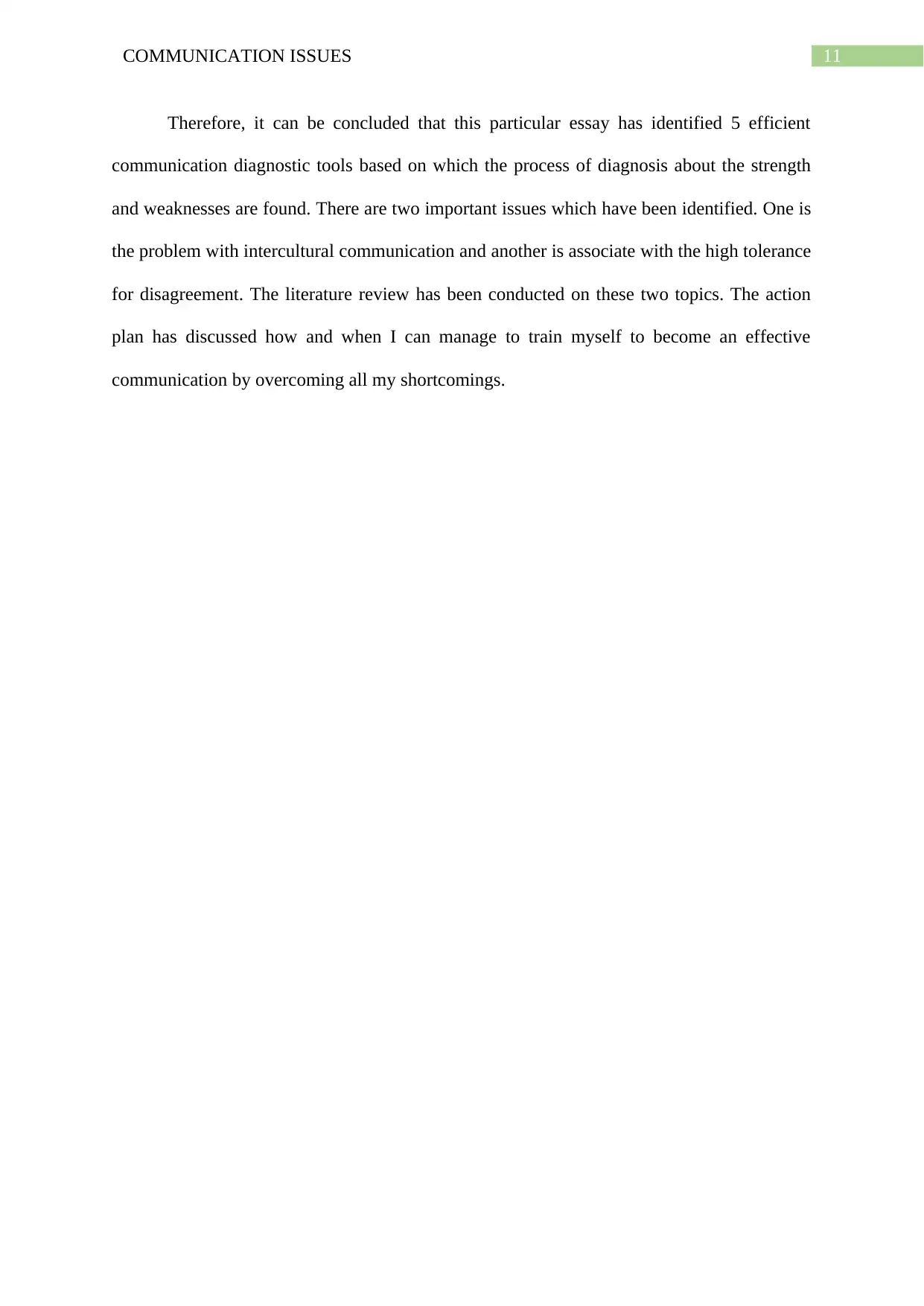
11COMMUNICATION ISSUES
Therefore, it can be concluded that this particular essay has identified 5 efficient
communication diagnostic tools based on which the process of diagnosis about the strength
and weaknesses are found. There are two important issues which have been identified. One is
the problem with intercultural communication and another is associate with the high tolerance
for disagreement. The literature review has been conducted on these two topics. The action
plan has discussed how and when I can manage to train myself to become an effective
communication by overcoming all my shortcomings.
Therefore, it can be concluded that this particular essay has identified 5 efficient
communication diagnostic tools based on which the process of diagnosis about the strength
and weaknesses are found. There are two important issues which have been identified. One is
the problem with intercultural communication and another is associate with the high tolerance
for disagreement. The literature review has been conducted on these two topics. The action
plan has discussed how and when I can manage to train myself to become an effective
communication by overcoming all my shortcomings.
⊘ This is a preview!⊘
Do you want full access?
Subscribe today to unlock all pages.

Trusted by 1+ million students worldwide
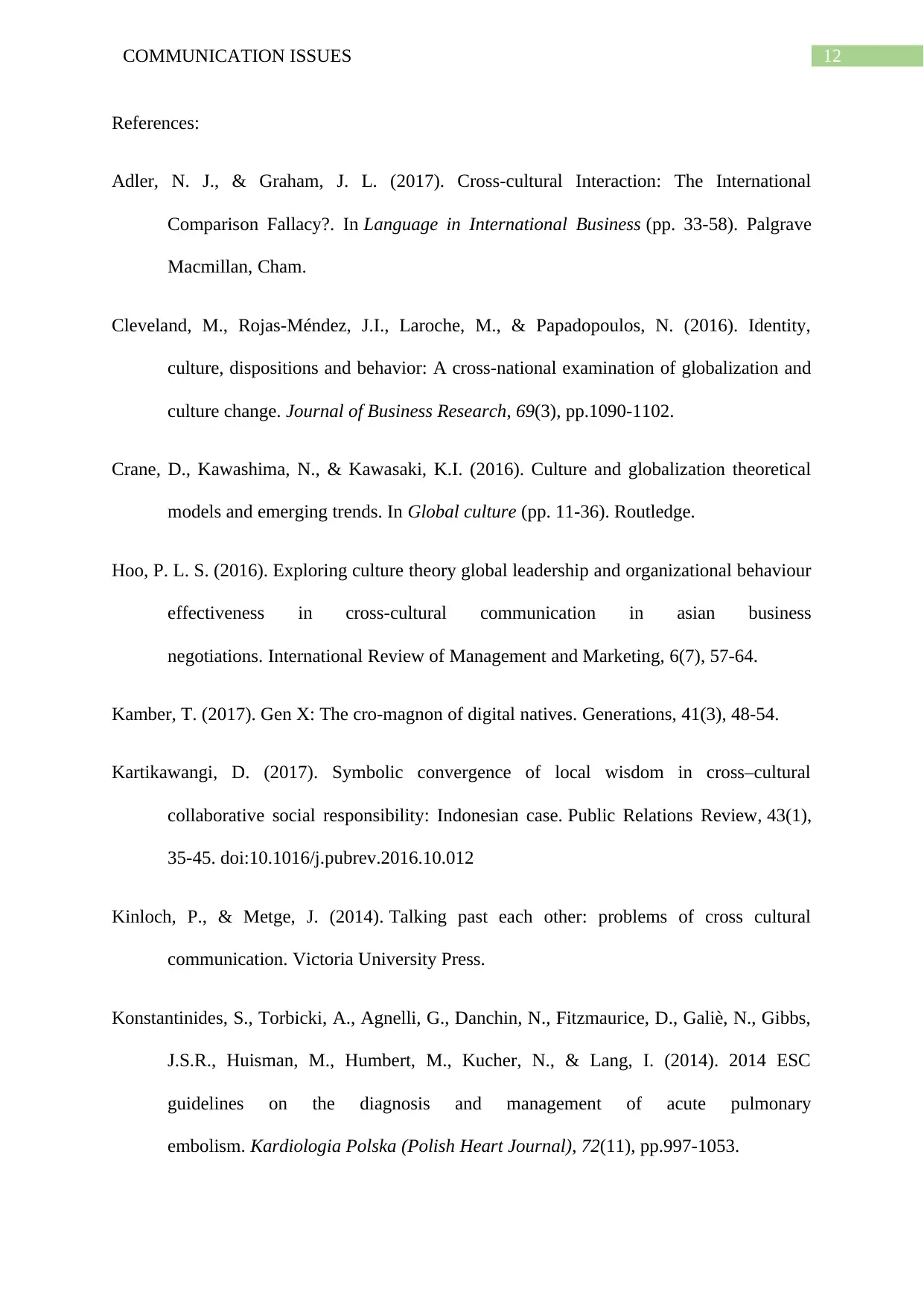
12COMMUNICATION ISSUES
References:
Adler, N. J., & Graham, J. L. (2017). Cross-cultural Interaction: The International
Comparison Fallacy?. In Language in International Business (pp. 33-58). Palgrave
Macmillan, Cham.
Cleveland, M., Rojas-Méndez, J.I., Laroche, M., & Papadopoulos, N. (2016). Identity,
culture, dispositions and behavior: A cross-national examination of globalization and
culture change. Journal of Business Research, 69(3), pp.1090-1102.
Crane, D., Kawashima, N., & Kawasaki, K.I. (2016). Culture and globalization theoretical
models and emerging trends. In Global culture (pp. 11-36). Routledge.
Hoo, P. L. S. (2016). Exploring culture theory global leadership and organizational behaviour
effectiveness in cross-cultural communication in asian business
negotiations. International Review of Management and Marketing, 6(7), 57-64.
Kamber, T. (2017). Gen X: The cro-magnon of digital natives. Generations, 41(3), 48-54.
Kartikawangi, D. (2017). Symbolic convergence of local wisdom in cross–cultural
collaborative social responsibility: Indonesian case. Public Relations Review, 43(1),
35-45. doi:10.1016/j.pubrev.2016.10.012
Kinloch, P., & Metge, J. (2014). Talking past each other: problems of cross cultural
communication. Victoria University Press.
Konstantinides, S., Torbicki, A., Agnelli, G., Danchin, N., Fitzmaurice, D., Galiè, N., Gibbs,
J.S.R., Huisman, M., Humbert, M., Kucher, N., & Lang, I. (2014). 2014 ESC
guidelines on the diagnosis and management of acute pulmonary
embolism. Kardiologia Polska (Polish Heart Journal), 72(11), pp.997-1053.
References:
Adler, N. J., & Graham, J. L. (2017). Cross-cultural Interaction: The International
Comparison Fallacy?. In Language in International Business (pp. 33-58). Palgrave
Macmillan, Cham.
Cleveland, M., Rojas-Méndez, J.I., Laroche, M., & Papadopoulos, N. (2016). Identity,
culture, dispositions and behavior: A cross-national examination of globalization and
culture change. Journal of Business Research, 69(3), pp.1090-1102.
Crane, D., Kawashima, N., & Kawasaki, K.I. (2016). Culture and globalization theoretical
models and emerging trends. In Global culture (pp. 11-36). Routledge.
Hoo, P. L. S. (2016). Exploring culture theory global leadership and organizational behaviour
effectiveness in cross-cultural communication in asian business
negotiations. International Review of Management and Marketing, 6(7), 57-64.
Kamber, T. (2017). Gen X: The cro-magnon of digital natives. Generations, 41(3), 48-54.
Kartikawangi, D. (2017). Symbolic convergence of local wisdom in cross–cultural
collaborative social responsibility: Indonesian case. Public Relations Review, 43(1),
35-45. doi:10.1016/j.pubrev.2016.10.012
Kinloch, P., & Metge, J. (2014). Talking past each other: problems of cross cultural
communication. Victoria University Press.
Konstantinides, S., Torbicki, A., Agnelli, G., Danchin, N., Fitzmaurice, D., Galiè, N., Gibbs,
J.S.R., Huisman, M., Humbert, M., Kucher, N., & Lang, I. (2014). 2014 ESC
guidelines on the diagnosis and management of acute pulmonary
embolism. Kardiologia Polska (Polish Heart Journal), 72(11), pp.997-1053.
Paraphrase This Document
Need a fresh take? Get an instant paraphrase of this document with our AI Paraphraser
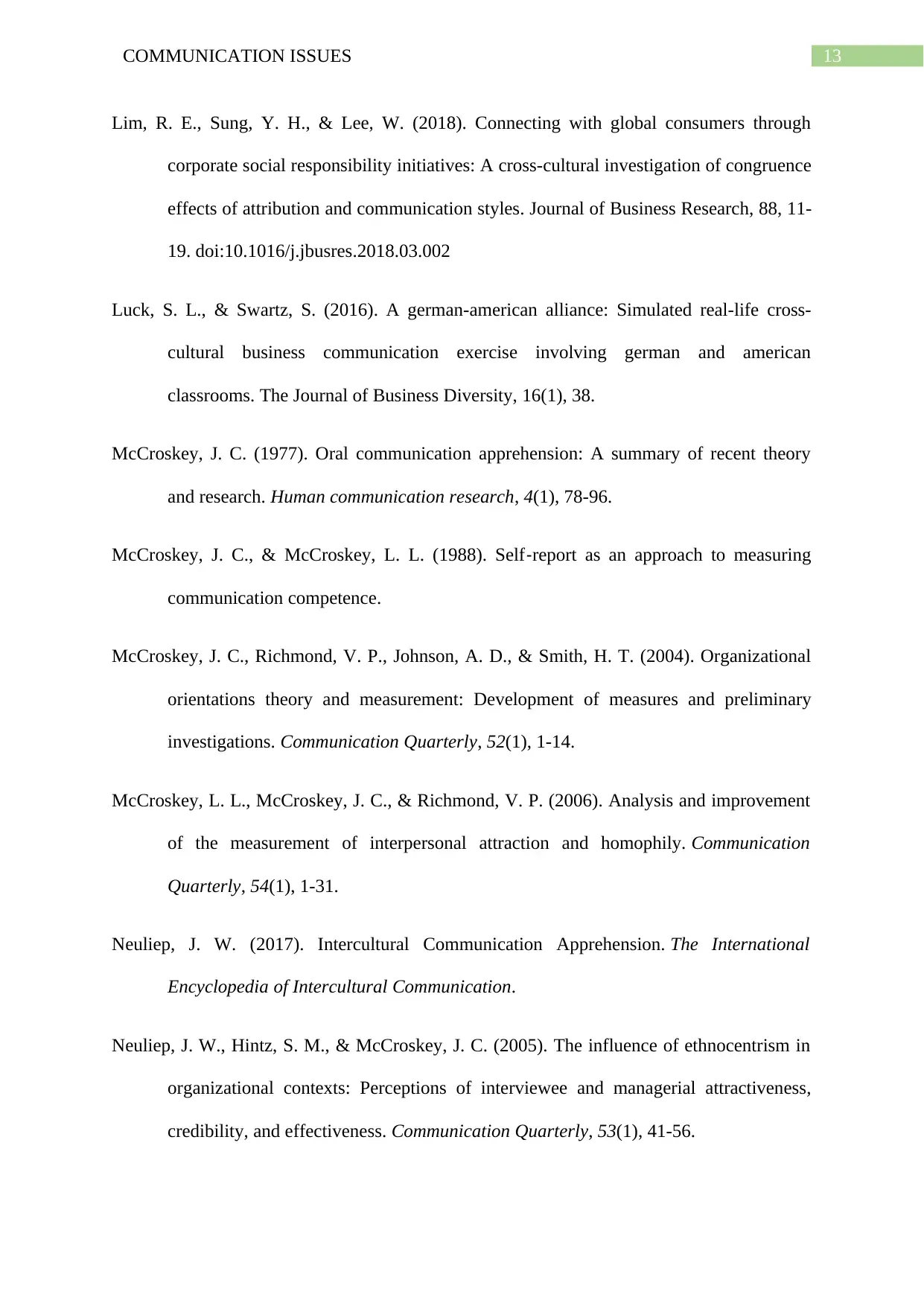
13COMMUNICATION ISSUES
Lim, R. E., Sung, Y. H., & Lee, W. (2018). Connecting with global consumers through
corporate social responsibility initiatives: A cross-cultural investigation of congruence
effects of attribution and communication styles. Journal of Business Research, 88, 11-
19. doi:10.1016/j.jbusres.2018.03.002
Luck, S. L., & Swartz, S. (2016). A german-american alliance: Simulated real-life cross-
cultural business communication exercise involving german and american
classrooms. The Journal of Business Diversity, 16(1), 38.
McCroskey, J. C. (1977). Oral communication apprehension: A summary of recent theory
and research. Human communication research, 4(1), 78-96.
McCroskey, J. C., & McCroskey, L. L. (1988). Self‐report as an approach to measuring
communication competence.
McCroskey, J. C., Richmond, V. P., Johnson, A. D., & Smith, H. T. (2004). Organizational
orientations theory and measurement: Development of measures and preliminary
investigations. Communication Quarterly, 52(1), 1-14.
McCroskey, L. L., McCroskey, J. C., & Richmond, V. P. (2006). Analysis and improvement
of the measurement of interpersonal attraction and homophily. Communication
Quarterly, 54(1), 1-31.
Neuliep, J. W. (2017). Intercultural Communication Apprehension. The International
Encyclopedia of Intercultural Communication.
Neuliep, J. W., Hintz, S. M., & McCroskey, J. C. (2005). The influence of ethnocentrism in
organizational contexts: Perceptions of interviewee and managerial attractiveness,
credibility, and effectiveness. Communication Quarterly, 53(1), 41-56.
Lim, R. E., Sung, Y. H., & Lee, W. (2018). Connecting with global consumers through
corporate social responsibility initiatives: A cross-cultural investigation of congruence
effects of attribution and communication styles. Journal of Business Research, 88, 11-
19. doi:10.1016/j.jbusres.2018.03.002
Luck, S. L., & Swartz, S. (2016). A german-american alliance: Simulated real-life cross-
cultural business communication exercise involving german and american
classrooms. The Journal of Business Diversity, 16(1), 38.
McCroskey, J. C. (1977). Oral communication apprehension: A summary of recent theory
and research. Human communication research, 4(1), 78-96.
McCroskey, J. C., & McCroskey, L. L. (1988). Self‐report as an approach to measuring
communication competence.
McCroskey, J. C., Richmond, V. P., Johnson, A. D., & Smith, H. T. (2004). Organizational
orientations theory and measurement: Development of measures and preliminary
investigations. Communication Quarterly, 52(1), 1-14.
McCroskey, L. L., McCroskey, J. C., & Richmond, V. P. (2006). Analysis and improvement
of the measurement of interpersonal attraction and homophily. Communication
Quarterly, 54(1), 1-31.
Neuliep, J. W. (2017). Intercultural Communication Apprehension. The International
Encyclopedia of Intercultural Communication.
Neuliep, J. W., Hintz, S. M., & McCroskey, J. C. (2005). The influence of ethnocentrism in
organizational contexts: Perceptions of interviewee and managerial attractiveness,
credibility, and effectiveness. Communication Quarterly, 53(1), 41-56.
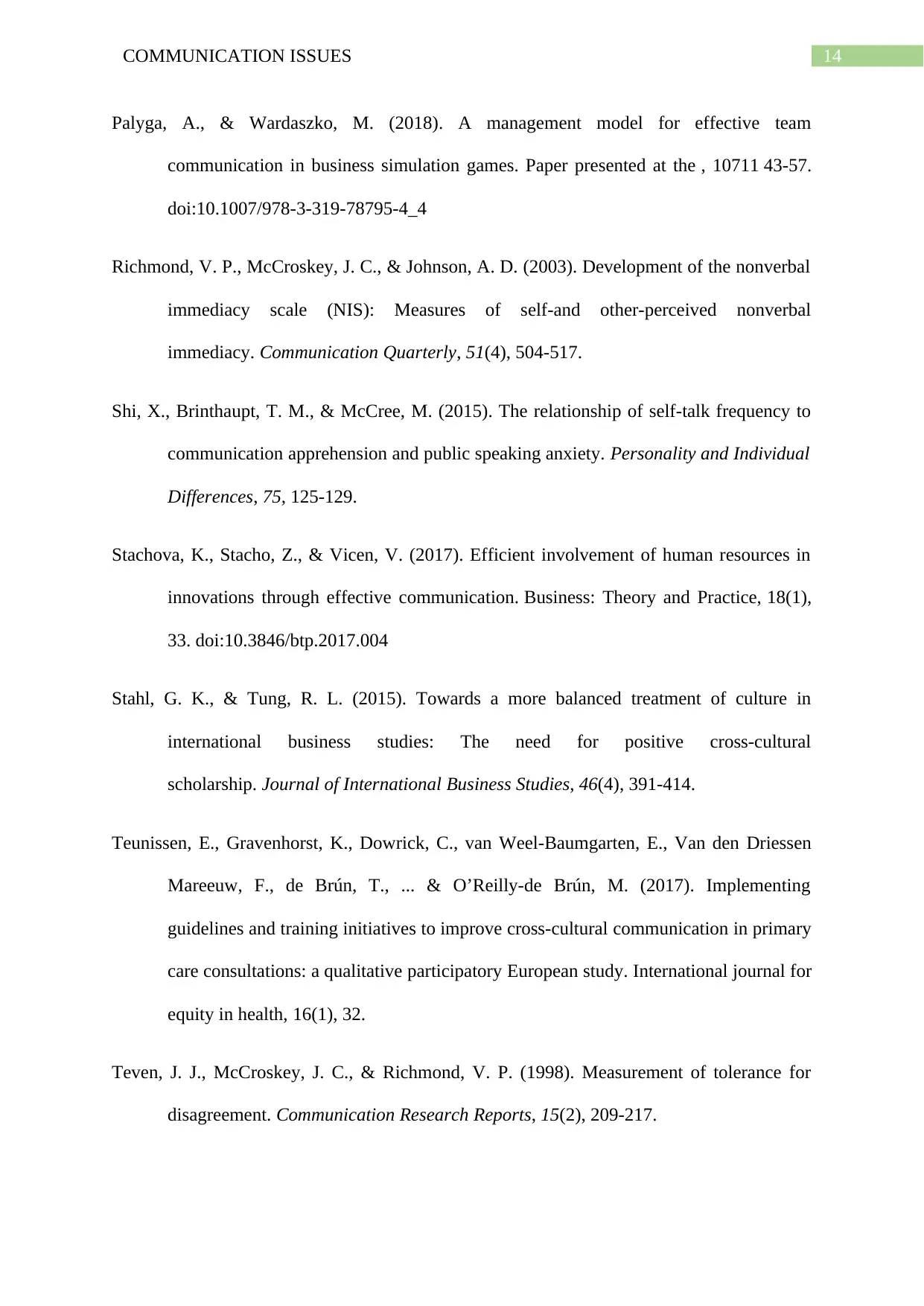
14COMMUNICATION ISSUES
Palyga, A., & Wardaszko, M. (2018). A management model for effective team
communication in business simulation games. Paper presented at the , 10711 43-57.
doi:10.1007/978-3-319-78795-4_4
Richmond, V. P., McCroskey, J. C., & Johnson, A. D. (2003). Development of the nonverbal
immediacy scale (NIS): Measures of self‐and other‐perceived nonverbal
immediacy. Communication Quarterly, 51(4), 504-517.
Shi, X., Brinthaupt, T. M., & McCree, M. (2015). The relationship of self-talk frequency to
communication apprehension and public speaking anxiety. Personality and Individual
Differences, 75, 125-129.
Stachova, K., Stacho, Z., & Vicen, V. (2017). Efficient involvement of human resources in
innovations through effective communication. Business: Theory and Practice, 18(1),
33. doi:10.3846/btp.2017.004
Stahl, G. K., & Tung, R. L. (2015). Towards a more balanced treatment of culture in
international business studies: The need for positive cross-cultural
scholarship. Journal of International Business Studies, 46(4), 391-414.
Teunissen, E., Gravenhorst, K., Dowrick, C., van Weel-Baumgarten, E., Van den Driessen
Mareeuw, F., de Brún, T., ... & O’Reilly-de Brún, M. (2017). Implementing
guidelines and training initiatives to improve cross-cultural communication in primary
care consultations: a qualitative participatory European study. International journal for
equity in health, 16(1), 32.
Teven, J. J., McCroskey, J. C., & Richmond, V. P. (1998). Measurement of tolerance for
disagreement. Communication Research Reports, 15(2), 209-217.
Palyga, A., & Wardaszko, M. (2018). A management model for effective team
communication in business simulation games. Paper presented at the , 10711 43-57.
doi:10.1007/978-3-319-78795-4_4
Richmond, V. P., McCroskey, J. C., & Johnson, A. D. (2003). Development of the nonverbal
immediacy scale (NIS): Measures of self‐and other‐perceived nonverbal
immediacy. Communication Quarterly, 51(4), 504-517.
Shi, X., Brinthaupt, T. M., & McCree, M. (2015). The relationship of self-talk frequency to
communication apprehension and public speaking anxiety. Personality and Individual
Differences, 75, 125-129.
Stachova, K., Stacho, Z., & Vicen, V. (2017). Efficient involvement of human resources in
innovations through effective communication. Business: Theory and Practice, 18(1),
33. doi:10.3846/btp.2017.004
Stahl, G. K., & Tung, R. L. (2015). Towards a more balanced treatment of culture in
international business studies: The need for positive cross-cultural
scholarship. Journal of International Business Studies, 46(4), 391-414.
Teunissen, E., Gravenhorst, K., Dowrick, C., van Weel-Baumgarten, E., Van den Driessen
Mareeuw, F., de Brún, T., ... & O’Reilly-de Brún, M. (2017). Implementing
guidelines and training initiatives to improve cross-cultural communication in primary
care consultations: a qualitative participatory European study. International journal for
equity in health, 16(1), 32.
Teven, J. J., McCroskey, J. C., & Richmond, V. P. (1998). Measurement of tolerance for
disagreement. Communication Research Reports, 15(2), 209-217.
⊘ This is a preview!⊘
Do you want full access?
Subscribe today to unlock all pages.

Trusted by 1+ million students worldwide

15COMMUNICATION ISSUES
Thomas, D. C., & Peterson, M. F. (2017). Cross-cultural management: Essential concepts.
Sage Publications.
Zhang, J., & Shi, Y. (2017). The application of vague language in international business
negotiations from a cross-cultural perspective. Theory and Practice in Language
Studies, 7(7), 585. doi:10.17507/tpls.0707.13
Thomas, D. C., & Peterson, M. F. (2017). Cross-cultural management: Essential concepts.
Sage Publications.
Zhang, J., & Shi, Y. (2017). The application of vague language in international business
negotiations from a cross-cultural perspective. Theory and Practice in Language
Studies, 7(7), 585. doi:10.17507/tpls.0707.13
1 out of 16
Related Documents
Your All-in-One AI-Powered Toolkit for Academic Success.
+13062052269
info@desklib.com
Available 24*7 on WhatsApp / Email
![[object Object]](/_next/static/media/star-bottom.7253800d.svg)
Unlock your academic potential
© 2024 | Zucol Services PVT LTD | All rights reserved.




